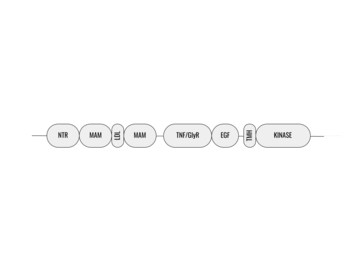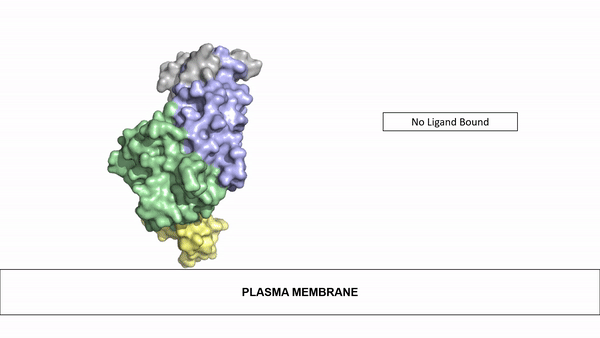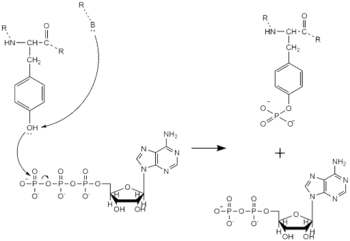Sandbox Reserved 1705
From Proteopedia
(Difference between revisions)
| Line 19: | Line 19: | ||
== Applications == | == Applications == | ||
| - | Anaplastic lymphoma kinase's involvement as a proto-oncogene in various types of cancers has made it a target for drug therapies for these types of cancers <ref name="Lewis">PMID:22734674</ref>. These treatments are utilized on the basis that overactivation of the kinase domain of ALK by ATP binding is causing the cells to send out growth signals more rapidly than usual. This over expression of growth signals allows the cancer cells to grow more rapidly than our normal cells. One therapeutic medication that has been increasingly used with high levels of success is <scene name='90/904309/Crizotinib/1'>Crizotinib</scene>. This medication was approved by the FDA in January of 2021 for the treatment of pediatric/young adult ALK-positive anaplastic large cell lymphoma. ALK-positive cancers are those in which the individual has an oncogenic mutation in their ALK protein sequence that is contributing to the proliferation of the cancer cells. The treatment has an overall response rate of 90%. Crizotinib works by <scene name='90/904309/Kinase_crizotinib/1'>binding</scene> to the ATP binding site of the <scene name='90/904309/Kinase_domain/1'>kinase domain</scene> <ref name="Sahu">PMID:24455567</ref>. Crizotinib binds preferentially to ATP in this region and therefore can effectively block the binding of ATP <ref name="Sahu" />. With the binding of ATP being blocked, the intercellular signaling cascade cannot begin which works to prevent cancerous cells from growing and spreading . Crizotinib also potently inhibits the RTK, [https://en.wikipedia.org/wiki/C-Met cMET], due to it's kinase domain ATP binding site being very similar to ALK's both sequentially and structurally. Other than inhibiting cMET, critotinib is regarded as a highly successful drug as it is very specific to ALK's kinase domain ATP binding site. | + | Anaplastic lymphoma kinase's involvement as a proto-oncogene in various types of cancers has made it a target for drug therapies for these types of cancers <ref name="Lewis">PMID:22734674</ref>. These treatments are utilized on the basis that overactivation of the kinase domain of ALK by ATP binding is causing the cells to send out growth signals more rapidly than usual. This over expression of growth signals allows the cancer cells to grow more rapidly than our normal cells. One therapeutic medication that has been increasingly used with high levels of success is <scene name='90/904309/Crizotinib/1'>Crizotinib</scene>. This medication was approved by the FDA in January of 2021 for the treatment of pediatric/young adult ALK-positive anaplastic large cell lymphoma. ALK-positive cancers are those in which the individual has an oncogenic mutation in their ALK protein sequence that is contributing to the proliferation of the cancer cells. The treatment has an overall response rate of 90%. Crizotinib works by <scene name='90/904309/Kinase_crizotinib/1'>binding</scene> to the ATP binding site of the <scene name='90/904309/Kinase_domain/1'>kinase domain</scene> <ref name="Sahu">PMID:24455567</ref>. Crizotinib binds preferentially to ATP in this region and therefore can effectively block the binding of ATP <ref name="Sahu" />. With the binding of ATP being blocked, the intercellular signaling cascade cannot begin which works to prevent cancerous cells from growing and spreading . Crizotinib also potently inhibits the RTK, [https://en.wikipedia.org/wiki/C-Met cMET], due to it's kinase domain ATP binding site being very similar to ALK's both sequentially and structurally <ref name="Wang">PMID:25399641</ref>. Other than inhibiting cMET, critotinib is regarded as a highly successful drug as it is very specific to ALK's kinase domain ATP binding site <ref name="Wang">PMID:25399641</ref>. |
</StructureSection> | </StructureSection> | ||
Revision as of 16:36, 6 April 2022
| This Sandbox is Reserved from February 28 through September 1, 2022 for use in the course CH462 Biochemistry II taught by R. Jeremy Johnson at the Butler University, Indianapolis, USA. This reservation includes Sandbox Reserved 1700 through Sandbox Reserved 1729. |
To get started:
More help: Help:Editing |
| |||||||||||
References
- ↑ 1.0 1.1 Reshetnyak AV, Rossi P, Myasnikov AG, Sowaileh M, Mohanty J, Nourse A, Miller DJ, Lax I, Schlessinger J, Kalodimos CG. Mechanism for the activation of the anaplastic lymphoma kinase receptor. Nature. 2021 Dec;600(7887):153-157. doi: 10.1038/s41586-021-04140-8. Epub 2021, Nov 24. PMID:34819673 doi:http://dx.doi.org/10.1038/s41586-021-04140-8
- ↑ Palmer RH, Vernersson E, Grabbe C, Hallberg B. Anaplastic lymphoma kinase: signalling in development and disease. Biochem J. 2009 May 27;420(3):345-61. doi: 10.1042/BJ20090387. PMID:19459784 doi:http://dx.doi.org/10.1042/BJ20090387
- ↑ Li T, Stayrook SE, Tsutsui Y, Zhang J, Wang Y, Li H, Proffitt A, Krimmer SG, Ahmed M, Belliveau O, Walker IX, Mudumbi KC, Suzuki Y, Lax I, Alvarado D, Lemmon MA, Schlessinger J, Klein DE. Structural basis for ligand reception by anaplastic lymphoma kinase. Nature. 2021 Dec;600(7887):148-152. doi: 10.1038/s41586-021-04141-7. Epub 2021, Nov 24. PMID:34819665 doi:http://dx.doi.org/10.1038/s41586-021-04141-7
- ↑ Lewis RT, Bode CM, Choquette D, Potashman M, Romero K, Stellwagen JC, Teffera Y, Moore E, Whittington DA, Chen H, Epstein LF, Emkey R, Andrews PS, Yu V, Saffran DC, Xu M, Drew AE, Merkel P, Szilvassy S, Brake RL. The discovery and optimization of a novel class of potent, selective and orally bioavailable Anaplastic Lymphoma Kinase (ALK) Inhibitors with potential utility for the treatment of cancer. J Med Chem. 2012 Jun 26. PMID:22734674 doi:10.1021/jm3005866
- ↑ 5.0 5.1 Sahu A, Prabhash K, Noronha V, Joshi A, Desai S. Crizotinib: A comprehensive review. South Asian J Cancer. 2013 Apr;2(2):91-7. doi: 10.4103/2278-330X.110506. PMID:24455567 doi:http://dx.doi.org/10.4103/2278-330X.110506
- ↑ 6.0 6.1 Wang Q, Zorn JA, Kuriyan J. A structural atlas of kinases inhibited by clinically approved drugs. Methods Enzymol. 2014;548:23-67. doi: 10.1016/B978-0-12-397918-6.00002-1. PMID:25399641 doi:http://dx.doi.org/10.1016/B978-0-12-397918-6.00002-1
Student Contributors
- Kaylin Todor
- Rebekah White



